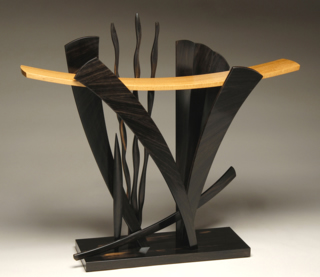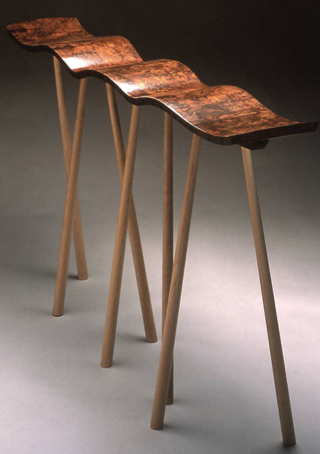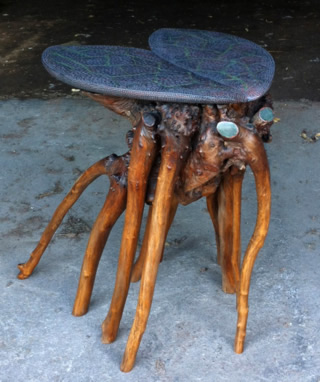Whimsy in Wood - Page 2
 |
|
|
 |
|
|
 |
|
|
One of his painted works is a recently built object that looks a bit more like a mosquito than like the table it purportedly may be. Its body began as a found object of burl. The wings, which aren't quite flat enough to safely support a martini glass, have an iridescent glow. And there's something startling about the eyes.
"Sometimes I just make something," Cullen says of the piece, adding, "It's furniture to scare the hell out of you." It sold immediately—thanks to Cullen's Facebook page, which has some 500 friends. "I always think furniture should be humorous," he says.
A Cullen piece can be quite traditional, in the tradition of the studio furniture artists who rediscovered the joy—and techniques—of hand-building furniture out of wood in the 1950s and 1960s.
Back then, studio furniture makers gloried in the natural feel, aroma, and touch of the wood, and many of Cullen's pieces do the same. His Massachusetts teacher was the legendary English craftsman David Powell, so he's got the techniques down.
But Cullen's use of color is far from traditional. "I love wood, but I also like the idea of color and pattern," he says.
Painting wood doesn't please some purists. When woodworkers such as Gary Knox Bennett, spurred on, perhaps by the Italian designers of the Memphis School, began painting their pieces in the post-modern 1980s, it caused a stir.
"Suddenly to be painting this wood that people had been lavishing attention on, with beautiful dovetail joints—suddenly to paint it, that was sacrilege!" Binzen says.
Today, says Ned Cooke, Jr., professor of American decorative arts at Yale University, studio furniture making, while emphasizing technical virtuosity, is more open to color and mixing materials.
Some work that used color and mixed media in the 1980s "pushed too hard. Now [furniture makers] are pulling back from that."
 |
|
|
 |
|
|
"That's where Michael's work is," says Cooke, who curated an exhibition that included two of Cullen's pieces. "I feel Michael's work is relatively quiet and thoughtful. There's a serenity to it, where the form and textures all work together."
Johnson, too, feels the work's serenity. "There's a friendliness and scale to his work that I like a lot," she says. "It's work one can easily incorporate into one's life and live with quite contentedly."
Cullen's 2,400-square-foot Blue Horse Studio, named for the handmade rocking horse out front, is well equipped, mostly with "old American stuff"—band saws, a joiner, an Oliver Machinery table saw dating to the 1940s—and, he says, getting better every year.
"I've always been into industrial design. The equipment is so beautiful," he says.
Still, about half of his work is by hand. "I'm not one of those who thinks handwork is better than machines," he says. "They both have their place."




